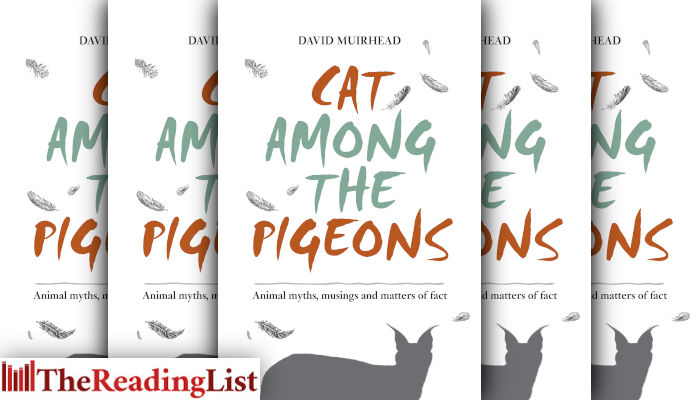Find out more about the Firefly in this excerpt from Cat Among the Pigeons, the new book from David Muirhead
More about the book!

Cat Among the Pigeons, the new book from David Muirhead, is out now from Penguin Random House SA!
Cat Among the Pigeons is another collection of Muirhead’s unrespectable creatures, following his successful book of hilarious animal stories, The Bedside Ark.
Muirhead’s mix of humour, mythology, anecdotal tales and folklore builds quirky and captivating portraits of each animal, and makes for a lighthearted, funny – as well as illuminating – read.
Read an excerpt:
Firefly
If you’d been paying proper attention in chemistry class you’d know that adenosine triphosphate (ATP to its friends) is a critically important macro molecule that acts as a power broker for virtually every cell in your body. All living creatures depend on it to do the things they do.
The forebears of fireflies worked out long ago that when you combine ATP with oxygen, calcium and the chemical luciferin in the presence of an enzyme called luciferase, light is produced. It’s tempting to speculate that if our own ancient ancestors had done their science homework properly, our noses would also light up when required and we wouldn’t need to burn billions of tons of fossil fuels to power our bedside reading lamps.
Firefly is a colloquial name for over 2,000 species of bio-luminescent insects that live in the world’s tropical and temperate zones. With the exception of a cave-dwelling fungus gnat that lives in New Zealand and Australia and generally minds its own business, none are flies and none can set the world on fire. Unlike even our most energy efficient bulbs, the light they produce generates virtually no heat.
True fireflies are nocturnal beetles, members of the Lampyridae family. They favour moist conditions and are hence usually found in or near marshes or where there’s plenty of damp leaf litter about, typically in forested or wooded areas by rivers, ponds and lakes. In their larval phase some are semi-aquatic.
Already boffins in chemistry, fireflies of the Photuris genus have gone to the top of the class in physics too, refining and sculpting the edges of the translucent scales in their exoskeleton to optimise light output. This neat trick has been experimentally copied to make LED lights 50 per cent more efficient.
Not only adult beetles light up. The larvae and even the eggs of many species also emit an eerie glow. The supposition is that the bugs first evolved their light show as a means of warning predators not to eat them. When alarmed, they exude a substance that tastes disgusting and is toxic to many undiscerning consumers. In the lethal trial-and-error process Nature favours, luminosity was a clever way of getting that message across.
But having mastered the science, fireflies subsequently worked out that flashing off and on is also a nifty way to communicate with each other, particularly when it’s time to find a mate. Some reprobates have gone one step further. They imitate the amorous flashes of other related species to lure unsuspecting suitors to join them as lunch.
Because there are so many different species, each adopting a slightly different approach to life’s chores and conundrums, it’s not surprising that we’re a bit confused about who’s who is the firefly zoo. About 30 species live in southern Africa, varying in size from 5 to 30 millimetres. Unsurprisingly, the name firefly is usually ascribed to those that fly, flitting about and flicking their little lamps on and off as the mood takes them. In some species only the male has wings and very large eyes but doesn’t light up at all; the female is flightless and emits a steady glow when ready to attract a mate. Females of this species look as though they never quite made it out of the larval stage and are hence often known as glow-worms. In the world at large, glow-worm is a name happily bandied about without any particular reference to entomological exactitude.
The bulk of a firefly’s modest lifespan is spent in the larval stage. They potter about in the underbrush and even underground, hunting and eating snails and worms. When they become adults most of them don’t eat at all, though some species find time in their busy schedule to take the occasional sip of nectar. Such brief visits to the juice bar aside, adult life for a firefly is firmly focused on finding a mate and, when conditions are favourable, their large numbers can produce an awe-inspiring light show.
Inexplicable things that shine in the night tend to ignite the human imagination and fireflies predictably attract more than their fair share of superstition. A legend of the Ewe people, who live in Togo and Ghana, holds that vampires routinely take the form of fireflies. If you’re stupid enough to catch one and put it in a jar, it will promptly overcome that inconvenience by assuming its true form and then eat your liver. In stark contrast, Japanese poets have long evoked the firefly as a symbol of enduring love and hope. In other cultures they are believed to provide some sort of electrical utility for elves and fairies. If this is indeed the case, we can sympathise with these diminutive citizens of the netherworld as they no doubt register regular complaints about the erratic nature of this essential public service.
Categories Non-fiction South Africa
Tags Book excerpts Book extracts Cat Among the Pigeons David Muirhead Penguin Random House SA
